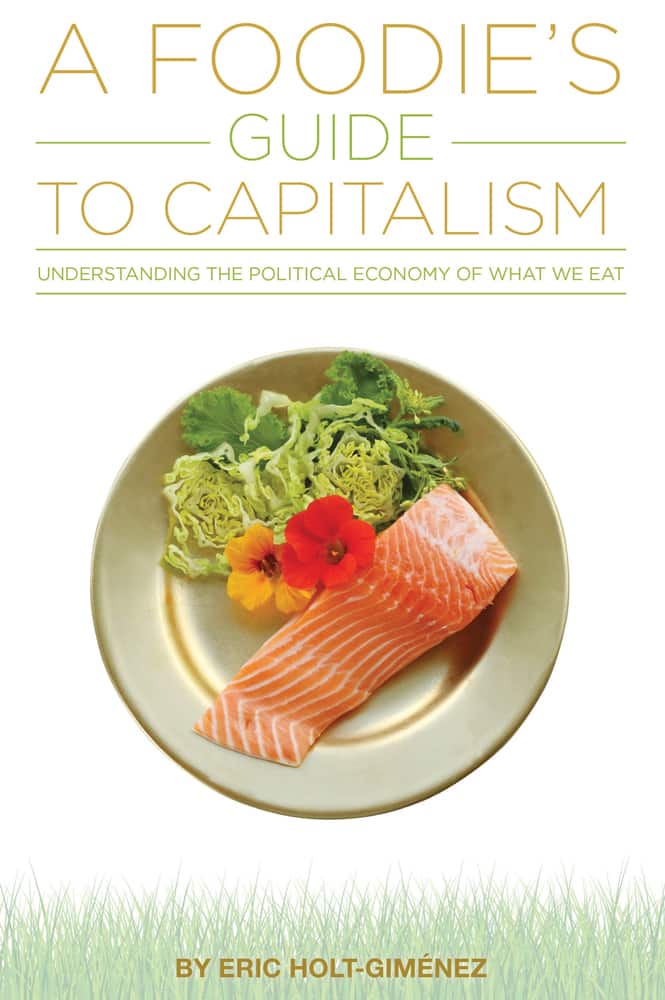By Teresa M. Mares, Journal of Agriculture, Food Systems, and Community Development, April 27, 2018
What role does love play in challenging the devastating impacts of capitalism on our food system? What role does hope play? For Holt-Giménez, the author of A Foodie’s Guide to Capitalism, both love and hope are essential in building a more just and sustainable world, and his newest book is inspired by his long career of allying with those “for whom giving up was not an option” (p. 240). Concluding a treatise on understanding the inner workings and history of capitalism with a call for love and hope might seem trite at first glance. And yet, this is perhaps the best indication of the narrowness and cynicism that often dominate the thinking of those of us who consider ourselves food activists. Another world is indeed possible, and Holt-Giménez gives us the tools we need to better understand the ways that capitalism—and racism—and sexism—and classism—stand in the way of that world. This is the kind of intersectional analysis that we need in the face of climate change, the plundering and privatization of our natural resources, and the ongoing attacks on democracy and progressive politics. A Foodie’s Guide to Capitalism allows the reader to understand how these kinds of wicked problems are interrelated with the ways that food is grown, distributed, consumed, and wasted.
Holt-Giménez takes us from his the first chapter, “How Our Capitalist Food System Came to Be,” and guides us through subsequent chapters focusing on the commodification of food, the birth of the private-property system amidst the growth of agriculture, power and privilege in the food system, and finally, the crises and solutions in our food system. The conclusion, entitled “Changing Everything: Food, Capitalism, and the Challenges of our Time,” reminds us that it is not only the food system that needs change but indeed, it is everything.
Holt-Giménez writes primarily for a U.S.-based audience, stating that this book “applies a food-systems framework to explain some of the basic workings of capitalism, and uses a basic understanding of capitalism to understand why the food system works as it does” (p. 14). This systems framework allows the author to take a holistic approach that acknowledges the interconnections between the food system and capitalism that food movement activists often overlook as they take on the immediate problems that confront them. As the author notes, this is understandable given the enormity of the problems, but it also “eclipses work to build longer-term political movements that could address the root causes of these problems” (p. 14). Combined with the fact that the political-economic structures of capitalism are often taken for granted as immutable, Holt-Giménez endeavors to denaturalize capitalism by outlining the ways that it has been deliberately built by those who stand to benefit from it.
One major strength of this book is its accessibility and readability, a testament to Holt-Giménez’s clear and coherent writing and narrative tone. I could equally imagine suggesting that my mother read this book in her pursuits to better understand the power of Monsanto and Cargill or assigning it to graduate students in our Ph.D. program in Food Systems who are grappling with social theory. Often overlooked in the back matter, the glossary offers a useful shortcut to the key concepts, institutions, and historical moments that are detailed in the book. The essays written by food activists like Rosalinda Guillen and George Naylor also lend a polyvocality that nicely complements Holt-Giménez’s own analysis. Moreover, the side-bars that zero in on topics such as “Food Waste at a Glance,” “The Pedagogy of the Oppressed,” and “Women Farmworkers” outline areas that the reader can explore further with the aid of the author’s helpful references.
As an anthropologist, I particularly appreciated the author’s historically rooted analysis of the co-evolution (or co-devolution) of private property, the commodification of food, and the changing nature of human social structure over time. This is precisely the take on history that I attempt to teach in my classes on food and culture, and I know that my students would find this concise yet detailed analysis exceedingly useful. Knowing this history is key to understanding our contemporary food system and how it shapes and is shaped by our cultural values and priorities. At its core, A Foodie’s Guide to Capitalism is an expertly written guidebook on how we might revalue food and those who bring it to our table as we work toward a more just and sustainable world.
As an anthropologist, I particularly appreciated the author’s historically rooted analysis of the co-evolution (or co-devolution) of private property, the commodification of food, and the changing nature of human social structure over time. This is precisely the take on history that I attempt to teach in my classes on food and culture, and I know that my students would find this concise yet detailed analysis exceedingly useful. Knowing this history is key to understanding our contemporary food system and how it shapes and is shaped by our cultural values and priorities. At its core, A Foodie’s Guide to Capitalism is an expertly written guidebook on how we might revalue food and those who bring it to our table as we work toward a more just and sustainable world.

No comments:
Post a Comment